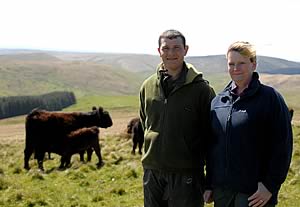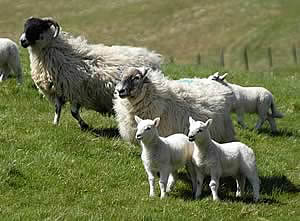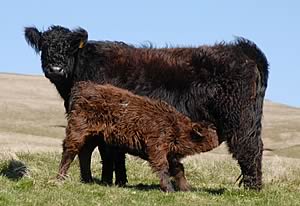 |
|||||||||
|
|||||||||||||||||||
|
|
On the Farming Ladder to Higher Level Stewardship Poppy and Neil Hindmarsh have got onto the farming ladder in one of the most beautiful and remote corners of the North East of England.
The couple took on the tenancy of the 2,500-acre hill farm Rowhope and the Trows near Harbottle in the uppermost reaches of the River Coquet in Northumberland bordering Scotland four years ago. Originally from farming families in the neighbouring valley of Redesdale, the Hindmarshs and their children Anna, six, and William, four, love their new home and farm which rises to 2,000ft at the aptly named Windy Gyle in the heart of the Cheviot hills and the Northumberland National Park. The farm is so remote that it has no mains electricity or water with electricity being generated and water taken from the spring. School for the children is nine miles away in Harbottle. Poppy and Neil spent a year in New Zealand from 2000 to 2001, Neil taking advantage of using his sheep shearing skills and both of them working in the wool sheds. They married in 2001 and invested in two lorries - a four wheeler and a six wheeler - transporting dressed stone, animal feed and wool from the region. These were sold with the move to Rowhope. Keen to get a farm of their own, there was no hesitation in taking on Rowhope, despite it being a hard hill farm with no in bye land. All feed has to be bought in for the farm’s hefted flock of 1,600 ewes and 400 hoggs on the hill which is part of the Ministry of Defence’s Otterburn training range. In 2007 the couple bought their first Galloway cows for their Rowhope herd, the females and calves also grazing the hill, the third highest in the Cheviot range, and hopefully helping in a bid to enter the Higher Level Stewardship scheme.
The flock’s seven hefts were Blackface sheep when the Hindmarshs took them on but because the farm is not suitable for finishing the lambs, Cheviot rams have been introduced to breed up a new flock. “We decided to cross through 800 ewes with a Lairg type Cheviot ram and last year we used a South Country Cheviot on a further 500 ewes, with the remainder going to the Blackie tup,” said Neil. “The grass stops growing here in October and we can’t finish lambs so they have to be sold store by then. “Last year we sold 1,000 Cheviot lambs which averaged £10 a head more than the 400 Blackfaces sold through Scott Lambie and Livestock Marketing (Borders). The Cheviot’s wool is also worth £1 a fleece more. “It makes sense because of our circumstances. The Cheviot crosses are every bit as hardy which is important when we can have some snow lying from November to April and eventually the ewes will be pure bred.” “We have found the South Country Cheviot crosses to have more wool and a heavier skin and they are a fleshy lamb straight off their mothers in September but as a finished lamb they will probably not be as heavy,” he added. The ewes are given feed blocks from the end of February to early May and are only fed hay in extreme weather conditions such as snow from hay huts on the hill. Lambing is from April 20 to mid May in an enclosure with ewes with twins turned onto better land - this year there were 300 pairs of twins. Soon after lambing the ewes and lambs go back to the fell. Weaning is in September and to save on transport costs lambs are sold from home to buyers in England as far afield as Shrewsbury.
One of the reasons for starting the Galloway herd was because the Hindmarshs have to buy in hay in case of inclement weather for the sheep it saves wasting it if it is not needed. The 13 foundation females were bought from Hindhope, Outer Huntly, Coldingham, High Creoch and from the Dryhope dispersal sale. All but two are registered. The aim is to run 25 females with a bull. As there are no livestock buildings on the farm, the cows and calves are outwintered at up to 1,500ft on the minimum of feed. Last winter they were fed five small hay bales a day from mid December to mid April. The bales are delivered in the summer to the hay huts by a tractor borrowed from the family but the farm’s only machinery is a quad bike and a snow mobile. The cows calve from the end of February extra females to build up numbers and herd replacements will be bought in to save changing the bull with the intention of building up a good pedigree herd. “Native breeds such as the Galloway and the Blue Grey are coming back into fashion partly because of environmental schemes but also because they are so easily kept requiring the minimum of feed which is an increasing cost, particularly taking into account haulage. There is definitely a place for them,” said Neil. In 2010 the current Stewardship agreement ends and the Hindmarshs are hoping that the features and management of the farm will enable them to enter the Higher Level scheme. The farm is criss-crossed with footpaths including a Roman road, The Street, and it is a place frequented by serious hill walkers. There is a late Bronze Age farmstead and settlement at Wardlaw, flora and fauna include heath and blanket bog. There is a variety of wildlife including buzzards, curlews, partridges and around 50 feral goats which roam close to the Border fence.
|
||||||||||||||||||

|
|
||||||||||||||||||
| home | agri-services | pedigree
pen | news | dairy | beef | machinery quota | property | organisations | site map |
|||||||||||||||||||

Article by
Jennifer MacKenzie


